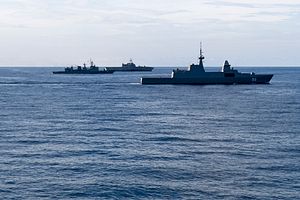On April 16, Singapore’s defense minister addressed a security forum in the Malaysian capital of Kuala Lumpur. Though his remarks touched on Asian security issues more broadly, they also included references to key items that the city-state is looking to advance during its chairmanship of the Association of Southeast Asian Nations (ASEAN) that bear careful watching.
As I have been noting in these pages, though Singapore is no stranger to taking a leadership role in advancing security issues among Southeast Asian states, there has been additional spotlight on the city-state as this year’s holder of the ASEAN chair. Though meetings will continue to take place throughout the year, the next key event will be the 32nd ASEAN Summit set to take place at the end of this month.
Singapore had already begun outlining the key items in its security agenda starting last year. As I noted during the last iteration of the Shangri-La Dialogue (SLD) in June last year, Singapore’s Defense Minister Ng Eng Hen had already begun previewing some of the city-state’s priorities (See: “Singapore Unveils New ASEAN Defense Initiatives Ahead of Chairmanship”). More details have subsequently been disclosed as well in line with its broader theme of “Resilience and Innovation” for the ASEAN chairmanship, including at the ASEAN Defense Ministers’ Meeting (ADMM) Retreat.
Singapore Defense Minister Ng Eng Hen’s address this week at the Putrajaya Forum, a biennial meeting held in Kuala Lumpur, offered another opportunity to outline the agenda for the next round of ASEAN meetings. And, unsurprisingly, he took that opportunity to disclose a few more specifics about three specific areas that the city-state had prioritized on the security side.
The first on Ng’s list was counterterrorism. That itself was no surprise, given the heightened threat around terrorism particularly following the siege by Islamic State-backed militants in the southern city of Marawi last year as well as Singapore’s role among other states in formulating a regional response to the challenge. Though the siege itself has ended, the threat from terrorism itself has not (See: “ASEAN’s Post-Marawi Islamic State Challenge”).
As I have been observing in these pages, there are no shortage of proposals within the region about how to counter the terrorism threat, with areas ranging from stopping terrorism financing to countering radical narratives online to subregional cooperation in the Sulu-Sulawesi Seas (See: “What’s Next for the ASEAN ‘Our Eyes’ Intelligence Initiative?”).
But Ng usefully highlighted Singapore’s proposal of a “3Rs” framework – resilience, response, and recovery – to bring together the multitude of ongoing counterterrorism initiatives. The focus, Ng said, was on a unifying framework to improve coordination and synergy, which is certainly much-needed on this front, along with a more holistic approach that is often lacking in practice even if it is appreciated in theory.
Second on Ng’s list was the strengthening of capabilities against chemical, biological, and radioactive (CBR) threats by terrorists and rogue states. Though this is by no means a new concern for Singapore or the region, the level of threat has increased, in part due to the aforementioned growing terrorism challenge but also in the wake of the urgency of the North Korean nuclear threat as well. Accordingly, the city state has been working with other countries, including neighbors like Malaysia as well as external partners like the United States, to find way to integrate this into the agenda.
Apart from governmental mechanisms, such as increasing information sharing between defense establishments, Ng said that one means by which the threat could be tackled was through the establishment of a virtual ASEAN network of CBR defense experts, thereby deepening the links among ASEAN experts and increasing the pool of capabilities to reach out to in the event of a disaster. Collective response in this respect would no doubt be key, especially given the vast differences in capacity across Southeast Asian states to deal with this both within government as well as beyond it.
Third and finally, Ng said Singapore wanted to facilitate the establishment of confidence building measures (CBMs) in the security realm. This, too, is not a new role for the city-state. Singapore has been at the forefront pushing for various CBMs over the years following the adoption of protocols at sea (CUES) by ADMM states – including in the air and the undersea domains (See: “Where is Singapore’s New Underwater Naval Protocol?”). Unsurprisingly, some of these proposals have not gained much traction within the multilateral context thus far.
In his remarks, Ng focused on the code for unplanned encounters in the air as well as at sea. And he also once again noted the ASEAN-China Maritime Exercise to be held later this year, which he said would help operationalize CUES. As I have noted before, Beijing has been proposing the exercise for years and it has finally been getting some traction, even though specifics remain to be worked out (See: “What’s Behind the New China-ASEAN Maritime Exercise?”).
We will hear much more in the way of specifics as Singapore’s ASEAN chairmanship progresses through the rest of 2018. And, as always, some ideas will make inroads this year, others will continue to germinate and then perhaps gain greater traction in the coming years as challenges evolve, and still others, such as the South China Sea, will see some hyped progress but with less actual gains (See: “Will a China-ASEAN South China Sea Code of Conduct Really Matter?”). As things evolve, how the security agenda progresses in the ASEAN context will continue to be interesting to watch.

































